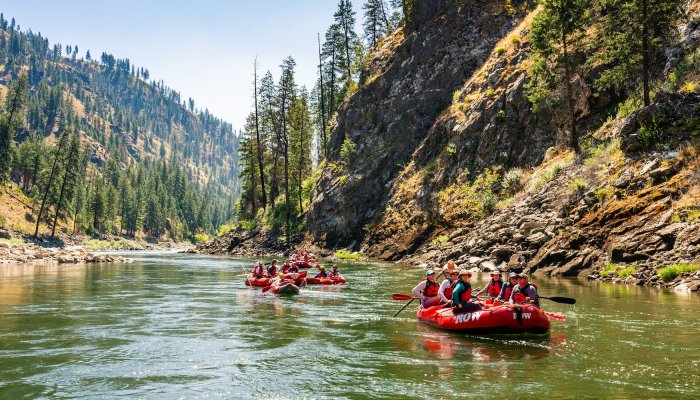Comparing the Lochsa, Tuolumne and Gauley Rivers
Idaho’s Lochsa, California’s Tuolumne, and West Virginia’s Gauley rivers are without a doubt the three best class IV rivers in the United States with commercial rafting trips that last between 1-3 three days. I’ve been lucky to have guided trips on all three of these rivers, as well as many others in the U.S. and around the world, giving me a good perspective as to what qualifies as a fantastic whitewater rafting trip. My hope is that this article will encourage rafting enthusiasts to get out and raft all three of these fantastic Class IV rivers.
The first of these that I ran was the Gauley in West Virginia. While I was in college I got a summer job as a rafting guide and during the summer of 1978, guided 101-day tours on the New River followed by 10 days on the Gauley over five weekends in September and October. This the primary Gauley season because a local reservoir is drawn down in preparation for winter rains.
At the end of the season, I returned home to California and spent much of the winter interviewing for whitewater guiding positions in the American West. In the spring of 1979, I trained on and then guided a few trips on the Tuolumne or “T” as it’s known, in California.
The rest of the 1979 rafting season was spent guiding in Idaho, and that fall I started my own rafting company, ROW Adventures. 5 years later, in 1984, ROW was awarded one of 5 permits to operate trips on the newly-opened-to-outfitting Lochsa River.
All 3 of these rivers offer paddle-smacking fun! In river talk, we speak of the gradient, which is the number of feet a river drops over the course of a mile. As rivers go, these are all quite steep, dropping around 20-40 feet per mile. Compare that to the 8’ per mile on the Colorado through the Grand Canyon, or 12’ per mile on the Snake River in Hells Canyon.
In terms of rapid classification, all three of these rivers are considered Class IV+. As well, all three rivers offer trips ranging from a day, to 2 or 3-day camping trips and each offers spectacular scenery.
Beyond these commonalities above, there are some differences as well. If you're considering whitewater rafting Idaho's thrilling Lochsa River, a quick comparison with West Virginia's Gauley River and California's Tuolumne River will help you prepare for your adventure.
Comparing the Rapids, Flows and White Water Characteristics of the Three Rivers
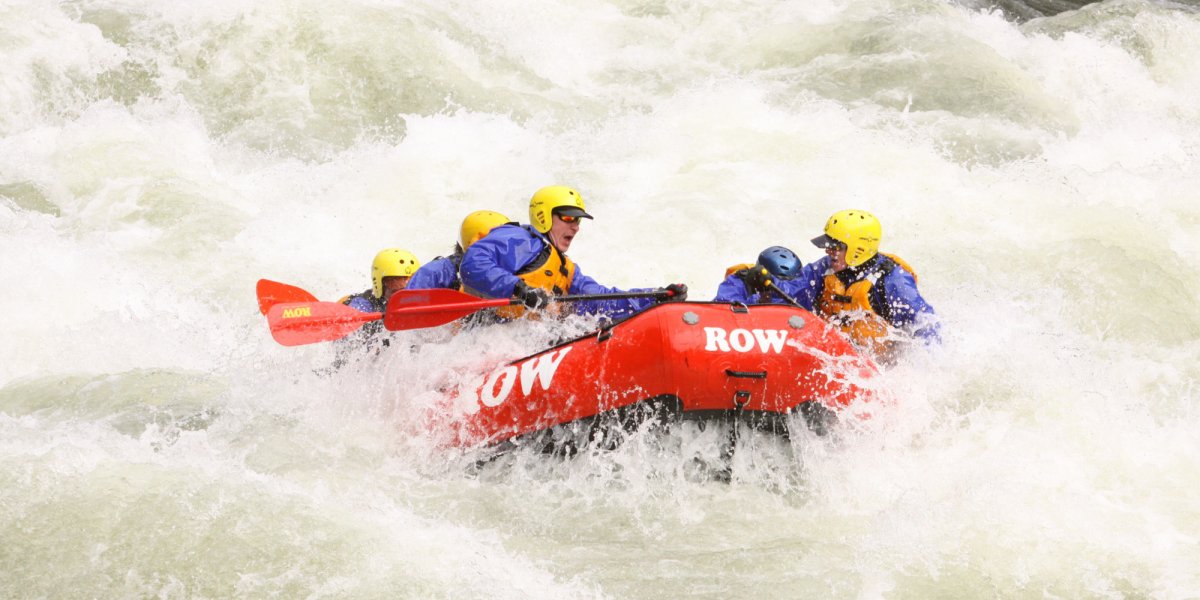
White water rafters on the Lochsa River in Idaho
Of the three, Idaho's Lochsa is the only one that is undammed and flowing free. Because of this, the season is from mid-April to mid-July as the snow melts in the high mountains of the river’s watershed. Snowpack and weather determine the flow; not a group of engineers operating gates on a dam!
The Lochsa has the biggest-volume flows of the three rivers, and it’s not uncommon for the spring melt to send the river running over 20,000 cubic feet per second (CFS). That's more water than you'll find on the Colorado in the Grand Canyon most of the time! During flows of 15,000 to 20,000, the waves are enormous, and one guide likened it to running all the rapids of the Grand Canyon in a day!
There are over 60 miles of free-flowing river on the Lochsa, making this trip the longest by far of the three rivers we are comparing. ROW Adventures offers trips from 1 to 3-days in length. 1-day trips go about 20 miles and are on either the Mile 138-121 section or the Mile 129 to 107 section. 2-day trips cover around 40 miles including the entire Class IV whitewater section from Mile 138 to 107 and our 3-day trips add another 20 miles upstream of this on Class II-III water that is a perfect warm-up for the more difficult rapids downstream.
High water on any river is always taken seriously, and that is true on the Lochsa as well. The greatest risk of high water is having swimmers if people fall out of a raft. The river is cold and moving fast, making rescue challenging. People often think that rafting a river at high water makes for the most exciting ride. This is only true to a point. Some rapids may be more exciting at high water, but others are more fun at low to medium flows.
What happens to rivers at high water is that the rocks that create the rapids are further below the surface. Thus, their ability to impact the river is minimized, and many rapids wash. However, rapids caused by constriction, (when the river’s banks squeeze the water together) may get larger. The lines that guides take through high-water rapids are less technical than at lower flows since the rocks are mostly covered. At high flows, the key to success is a team of rafters that will “dig in” with a hard-forward stroke to break through waves and holes while maintaining balance in the rodeo ride. An additional risk factor at high water on the Lochsa is that the water is (reminder: free-flowing snowmelt) cold! Outfitters on cold-water rivers generally provide wetsuits and other cold-weather gear and this is true for ROW’s Lochsa River trips as well.
In terms of rapids on the Lochsa, there are many! A few favorites are House Wave (a mere class III), the Grim Reaper, Termination, and Lochsa Falls. As flows decrease starting in mid-June and into July, the river warms and becomes more "pool and drop" in nature. The rapids also become much more "technical." Rapids such as Ten Pin and Horsetail Falls become very challenging at these levels. To keep the ride more exciting, ROW switches to smaller rafts when flows are in the 1000-4000 CFS range.
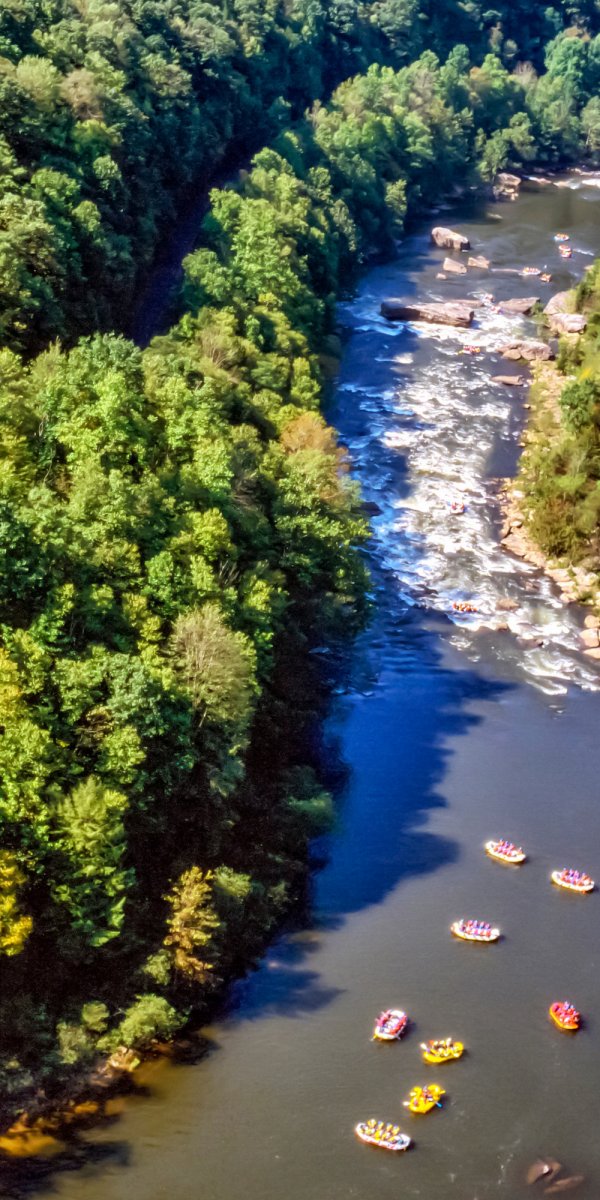
White water rafts on the Gauley River, West Virginia
2. The Gauley River in West Virginia
A challenging, technical river, most trips on the Gauley take place in the fall during planned releases to lower the water level in the Summersville Reservoir. As the flow in the fall season is strictly controlled dam-release, most trips take place at a flow rate of around 2,400-3000 CFS. This means you will have 'punchy' holes and waves, numerous maneuverings in complicated rock gardens, and distinct rapids separated by slower pools. Pillow rock is a favorite rapid. Many of the outfitters advertise the river as having "several class V rapids," but most guides place them at a IV+ (remember: the rating system rates how difficult a rapid is, not how much fun... also, difficulty on a given river can vary widely at different flows).
The Gauley whitewater stretch is 24 miles long in total. Outfitters on the river offer trips that divide this into an Upper and Lower section, as well as some that combine the two sections.
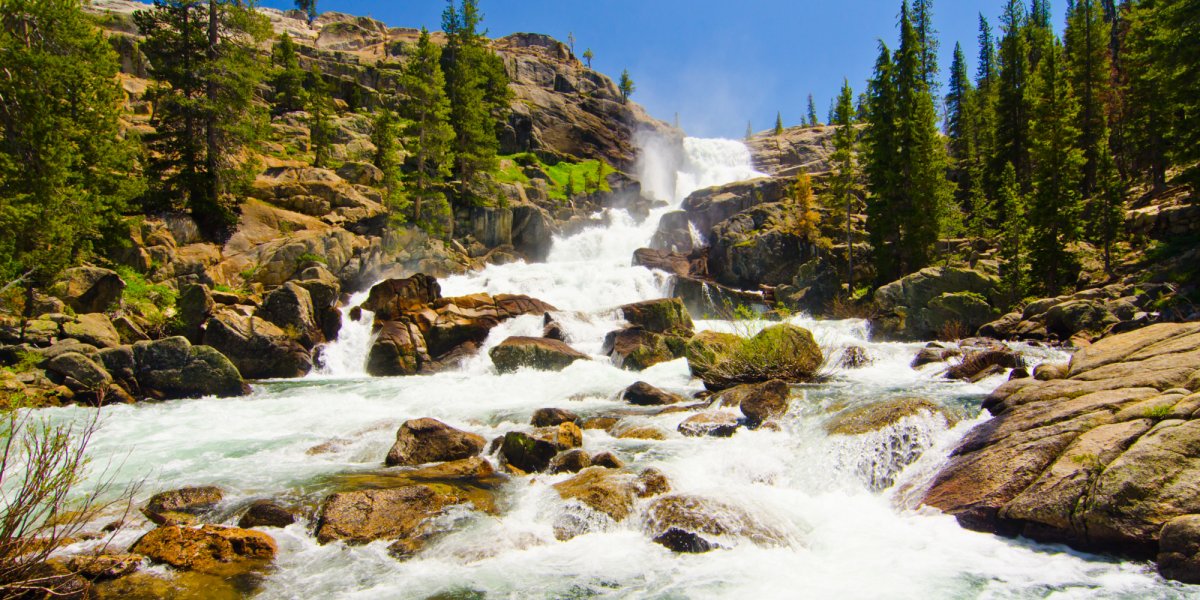
Tuolumne River at Glen Aulin at Yosemite National Park
3. The Tuolumne "T" River in California
Also a technical river, with a distinct 'pool and drop' character that diminishes at higher flows, the “T” is dam controlled and trips generally run from April to October. Flows are higher in the spring and range from 5,000 – 10,000 CFS. As summer goes on the river drops and trips could be as low as 400-500 CFS in August. Clavey Falls remains the T’s nemesis rapid.
Trips on the Tuolumne float 18 miles in total from a put-in point below the Hetch-Hetchy dam to the slack water of the Don Pedro reservoir.
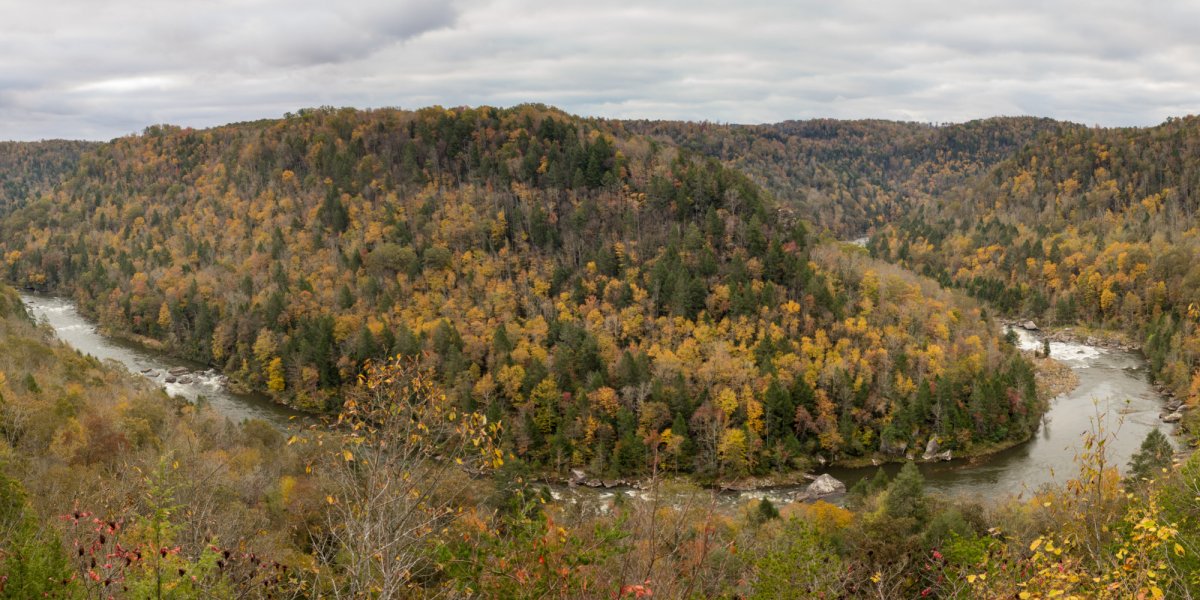
Overview of the Gauley River in West Virginia
A Comparison of Scenery, Geology, and Environment
All three rivers are spectacular in their own way, and again, we encourage you to raft them all to appreciate their beauty. Of the three, the Lochsa is the only one with a road along its banks. Fortunately, the road is dwarfed by the magnitude of the mountains that form the Lochsa canyon.
The Lochsa forms the southern boundary of the Selway-Bitterroot Wilderness Area. Considered an inland temperate rainforest, the landscape is lush and mountainous. Steep slopes covered in fir and pine rise up to the sky, while much of the river’s edge is lined with majestic western red cedar. Although not always easy to spot, bear, deer, elk, and moose are common in the dense vegetation and magical cedar groves. The colorful Harlequin duck is sometimes spotted on the river. Being a completely free-flowing river (no dams) adds to the feeling of 'wilderness' on the Lochsa.
The geology is primarily granitic rock of the Idaho batholith, which means the boulders are smooth and hard. However, because a road was built along the river in the 1950s and ’60s, rocks on the right side of the river can be sharp.
The Gauley River flows through a canyon of east coast hardwoods in the Appalachian Mountains. Conifer, birch and maple line this boulder-strewn river. As it is typically run in the fall, a bit of color can be expected. The combination of warm dam-released water and cool October air often creates a dense morning fog, adding an eerie feel to the river. Although development is minimal along the river itself, population density in the area, in general, reduces your chance of seeing larger wildlife.
The geology of the Gauley is limestone, which is softer than granite. Limestone rivers are considered riskier than those that have harder rocks, because the limestone, over hundreds and thousands of years, can become undercut by the river’s forces.
On the Tuolumne, you are in the foothills of the Sierra Mountains. Big, dry, granite domes and conifers are the norm. This is located in the dam-controlled Hetch-Hetchy Valley. The Hetch-Hetchy dam was built around 1913 to provide drinking water to the City of San Francisco and was very controversial. In the end, environmentalists felt they had to save Yosemite Valley itself from a dam on the Merced, and in so doing were forced to acquiesce to the construction of a dam on the Tuolumne. Although wildlife is more sparse in this dry environment, golden eagles and many other bird species live in the canyon. Clear running water and striking scenery make "the T" a California favorite. Like the Lochsa, the geology of the Tuolumne is primarily granitic.
Wild & Scenic Rivers
In 1968 the U.S. Congress passed the National Wild & Scenic Rivers Act to preserve certain rivers with outstanding natural, cultural, and recreational values in a free-flowing condition for the enjoyment of present and future generations. This means any river or river segment designated, can never be dammed.
When the Act was passed in 1968, one of the first 8 rivers designated, was the Middle Fork of the Clearwater and its tributaries the Lochsa and Selway. Idaho was the only state to have 2 of the 8 rivers included (the other being the Salmon River.)
The Tuolumne is also a designated Wild & Scenic river, earning that designation in 1984. The Gauley has been determined to be eligible for this federal designation but has yet to be included in the National Wild & Scenic Rivers Act. Clearly it is deserving, and we hope that will change.
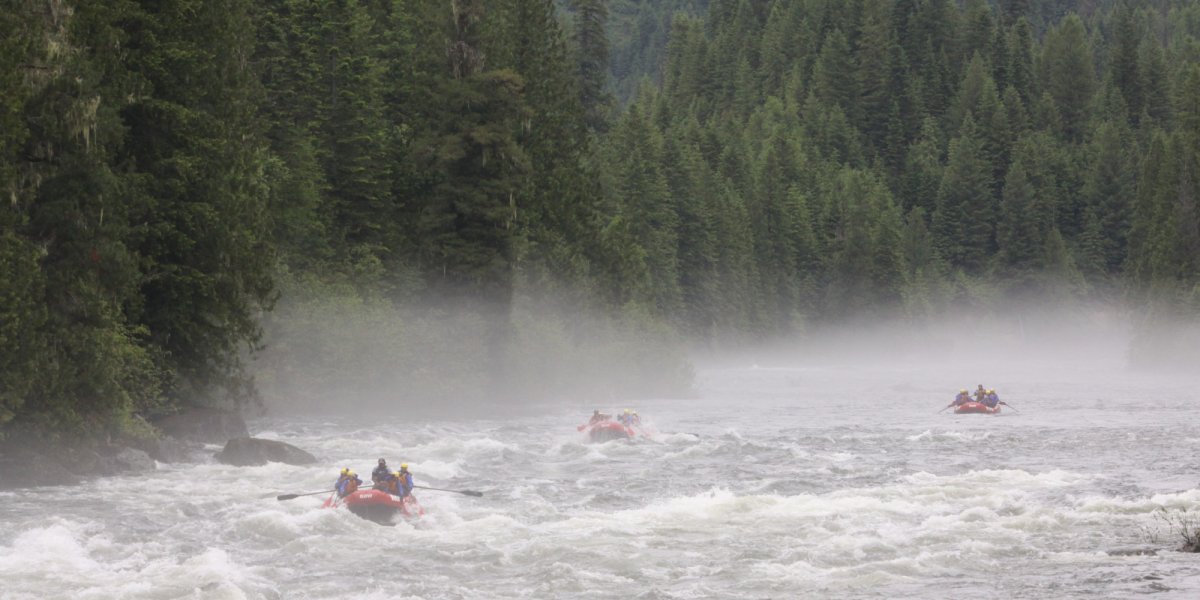
A foggy morning on the Lochsa River in Idaho
More on Idaho’s Lochsa River
The Lochsa is the most exciting whitewater rafting adventure in Idaho with more rapids per mile than any other. The Lochsa has more rapids than the Selway, bigger rapids than the Middle Fork of the Salmon or the fabulously remote Bruneau, and simply put, ranks as one of the world's great rafting trips.
People running the Lochsa are usually looking for a more extreme whitewater adrenaline experience that is a few notches up from ROW's other river rafting tours. We recommend previous whitewater experience before embarking on a Lochsa whitewater trip.
Many of our guests have traveled with us on other ROW one-day rafting trips such as the Clark Fork in Montana, Idaho's St. Joe river, or the Deschutes in central Oregon. Some have taken their family rafting down the Salmon River Canyons. On any of these whitewater adventures they would likely hear the guides humbly recount stories around the campfire about the "Mighty Lochsa." Other guests have traveled the country (or the world) running more difficult rivers and have sought out the Lochsa on reputation alone. We invite you to join us on the Lochsa where you are sure to create your own epic whitewater story!


